When using a screed in Birmingham in order to produce a level surface for the final flooring in a building, you have several different choices. Traditionally, a screed was made (and still is) from a mix of sand and cement. However, today there are several different kinds of screeds which are known as liquid screeds for the simple reason that they are in liquid form when pouring and installing them.
A flowing cement screed in Birmingham, which we can provide at Top Mix, has several benefits when compared with the traditional version. Apart from anything else, it is delivered to site ready mixed. A traditional screed is usually mixed on site with workers simply shovelling sand and cement into a mixer and then barrowing the resulting mix to the point where it is to be laid. Not only is this time-consuming, but each mix will be a little different from the last one. A liquid screed mixed off-site will be the same each time.
Poured Using A Hose
Then there is the time of application. A traditional screed is laid by a worker by hand using a trowel. When you use our flowing cement screed in Birmingham it is delivered to site ready mixed, and we then connect a long hose in order to pour the screed wherever it is required. As you can imagine, this saves a huge amount of time – and also money, because not much in the way of wages is involved. All we do once poured is level the surface with a dappling bar in order to remove any air bubbles and then leave it to dry. The screed will be dry enough to walk on within 24 – 48 hours.
A self-levelling screed is also perfect for use with underfloor heating. When you lay a traditional screed by hand it is almost impossible to cover every last part of the pipe of a water-based heating system, so there will always be air pockets here and there. This obviously affects the evenness of the heating into the room. With a liquid screed, this does not happen because the flowing screed will cover all the pipes leaving no air pockets.
Drying time is quicker too, in the sense that you can lay the final floor surface – tile, wood, or whatever you are using – a lot sooner than you can with a traditional screed. On any construction project, time is money, and so this is another big benefit.




